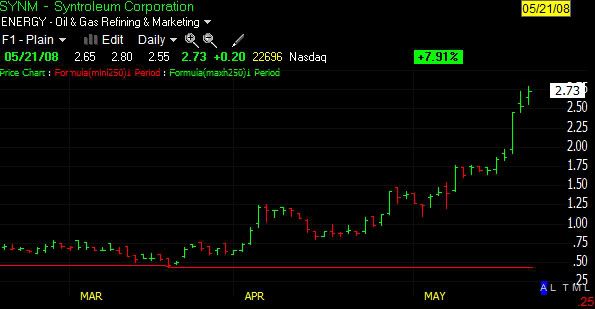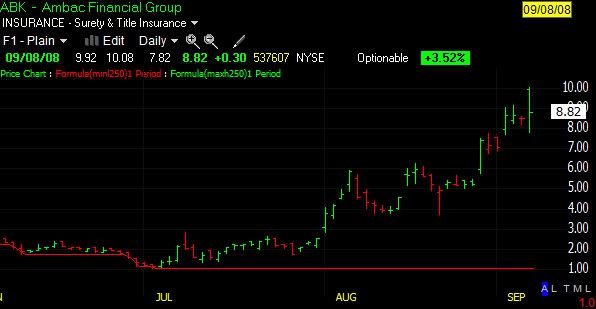
Registered User
Joined: 7/1/2008
Posts: 889
|
my backtesting skills are weak, but I've got a few interesting ideas that seem worth flushing out. Anyone interested to partner up? We'd need to be able to test a portfolio of multiple securities (just a handful) interacting as a portfolio based on quantitative signals. I could try to get adept at stockfinder, but I just don't have time.
|
|

Registered User
Joined: 7/1/2008
Posts: 889
|
I interested, please contact me at (email removed by moderator).
|
|
Registered User
Joined: 3/15/2010
Posts: 54
|
Sir, backtesting is ok to check the behavior of systems. Of course you must be able to test in the 3 kind of different markets conditions that can be possible. Not an easy task, and not cheap either - not for concise testing anyways.
But, systems are subject to users and what is more important to keep in mind is that history can't predict future.
There is nothing that can do that except the ability to change it and knowing when it will happen. Only very few have that priviledge.
|
|
Registered User
Joined: 4/10/2006
Posts: 954
|
Ben, I would like to help. I can not start for a couple of weeks. If you are still interested.
The stockfinder backtester is limited but it does give you an ideal of success/failure.
For instance the etf rotation based on monthly performance did not map well to the backtester, and requires externel processing on the data for backtesting. i.e. creating a rule for buys by selecting the best %change from the watchlist agains the watchlist.
Its easier just to export the data for the etfs for monthly data points and perform the buy/sell and calculate the gain/loss.
Not sure if this falls into your plans on the system mentioned above
regards
|
|
Registered User
Joined: 5/1/2007
Posts: 158
|
Ben:
Just what is it that you are trying to do? And what is your input. I've got a system that has generated picks for ten years, and another that has generated picks for 14 years.In 14 years, there have been about 9,000 picks, with entry and exit. The ten year run had some early bugs, because it didn't have stock split built into it (eg F was shown on my table as a loss, but it just split and I wouldn't have sold it in a live portfolio).
I've been a subscriber to tc2000, but am retired on low income - two divorces remove lots of gains. Basic rule is - buy low - but not too low - and filter on "good management" - I never bought Worldcom or Enron, and avoided Intel for years, because its head was close to Skilling from Enron (they wrote a book on leverage together). You can't write a screen for management, but you can plug in a fudge factor.
You may not want to give away the show, but what do you mean by quantitative signals? Something that you can grab daily out of Worden? If so, done that.
|
|
Registered User
Joined: 1/28/2005
Posts: 6,049
|
"Basic rule is - buy low - but not too low - and filter on "good management" - I never bought Worldcom or Enron, and avoided Intel for years, because its head was close to Skilling from Enron (they wrote a book on leverage together). You can't write a screen for management, but you can plug in a fudge factor."
======================================
Do you time anything or do you just stay long?
Thanks
diceman
|
|
Registered User
Joined: 5/1/2007
Posts: 158
|
Diceman:
I buy when I see a 2-5% dip in a stock I like (sometimes I buy stocks I don't "like", but like the chart). I've tried to short, but I tend to lose mine. Right now, I don't want to be long, but my system almost always has enough stocks to like. Use two systems, one averages 20 stocks per day, and the other about 75 per day. But the 20 per day one works a bit better.
No stop loss. Usually sell after a 2-5% bump up. That would be from the low close, not necessarily my entry. Of course, I try to enter near a bottom. Worst trade was a bad exit on CREE. Sold at the bottom. Most of the best trades are 5-7% in 1-3 days. I'm re-back testing it with alternate nudges.
|
|
Registered User
Joined: 1/28/2005
Posts: 6,049
|
Hi tllucero
Thanks for the info.
You had mentioned something about 14 year returns.
So I was wondering if you had "officially" done something about
periods like 2000-2002 or 2008 or if your system was "all in" for
14 years.
(like I only trade long when the SP-500 is above its 200 day average)
I think if your long returns are good enough you don't necessarily have to
be short. Just out of the market.
Also it would depend of the accuracy of your timing.
You can be generically short in 2008 but play the short-term
bounces long to try to get the best of both worlds.
Thanks
diceman
|
|

Registered User
Joined: 3/21/2006
Posts: 4,308
|
Tllucero, I too am curious? Since the current market conditions are rare and unprecedented (I have heard this from Larry Conners and Ben stated that he heard this from William O'neil), How does this tie in with back-tested performance? I know that certain scans that I use are deigned to find break-out patterns but in most cases "currently" the break-outs fail. Larry conners tries to capture 3% to 5% also but you must enter the stock very early based on certain criteria. I am not sure if this is your method as well but I would be interested in viewing a couple of your successful trades (charts if you can)..
Thanks for any help, I would appreciate it.
Also for the back-test journeymen how do you account for varying market conditions in reference to your tests. I would think that fine tuning your results to certain markets instead of a blanket test would be rewarding.
Apsll.
|
|

Registered User
Joined: 6/6/2005
Posts: 1,157
|
I would think that fine tuning your results to certain markets instead of a blanket test would be rewarding.
You're right about this Apsll,
I've just begun doing this, testing different methods in different market environments. 2000-2003, 2003-2007, 2007-2009, 2009-Present. It's giving me a clear picture of what to look for when it comes to what works best for me.
I have to agree with Diceman as well,
After looking at all the data I've looked at over the last few years I see that, unless the method suits you, there's no reason to be short. If what happened in 2009 is any indication of how markets react after bear markets (and it is because the same thing happened in March 2003) then the best thing to do is sit on profits from the last bull market and wait for EVERYTHING to go on sale, and then look for the early momentum breakouts at the end of a bear. The way to profile that end is with the 200 MA, and sometimes the 50 if the masrket is in steep sell-off mode.
If the market is trully in for another crash (like 1974-75) then I can think of nothing that would make me happier.
The tough part is sitting on your hands while the market is selling off, because I know we like to trade. Darvas has said he sat on his money from months to years at a time waiting ofr bears to pass. Oneil said he only made money in 2 out of the last 9 bear markets. Livemore however, thrived. it's all about what makes you tick.
You can also do what Zanger does and take small short positions just to keep you in the market and aware. I like Diceman's option of playing the bounces long. In 2008 there were 2 bounces - one in March and one in July...

The March bounce was a little over 11%, the July bounce a little over 7%.
That's not very impressive, but when you look at the Russell 3000 and see that during the March bounce 173 stocks gained greater than 50% and over 2200 were positive, then you can see there is opportunity to be had. Here's one of the big winners during that bounce.

That's a stock I wouldn't mind finding in any environemnt.
The thing that suprised me most was that during the small 7% bounce in July, 142 stocks gained greater than 50% and once again over 2200 were positive.
Here's a big winner for the July bounce -- Martha's fave, ABK:

The thing to do, I suppose would be to be able to qualify what a bounce is during a downtrending market and when it starts and when it ends.
You could use something as simple as a 10/20 MA cross on the indexes. I think that gave a couple false starts in 2008, but that's the nature of the game. It certainly caught the bounces we wanted to catch and early enough to use.
If you look at the Zanger game, which began in April (great timing haha) even trying to trade long while the markets are correcting is an impossible task. For me it would have been a much better idea to simply sit out since late April and saved the 30% I lost, or just taken small shorts. That's where self control and discipline comes in. And that's where the majority of the time and effort should be spent as far as I am concerned.
Something diceman said once has always stuck with me -- you have to pick your team. You have to decide what you're traidng, and how you're trading it. This makes more sense to me now than ever.
David John Hall
|
|
Registered User
Joined: 1/28/2005
Posts: 6,049
|
"In 2008 there were 2 bounces - one in March and one in July..."
Dont forget 11-20-2008. (that was actually the best, at least to me)
Thanks
diceman
|
|

Registered User
Joined: 6/6/2005
Posts: 1,157
|
Hey Diceman, you're absolutely right. It was the best bounce, period. Over 525 stocks in the Russell 3000 gained more than 50%, 70 gained 100% or better and over 2400 were positive. Those are impressive numbers.
|
|
|
Guest-1 |